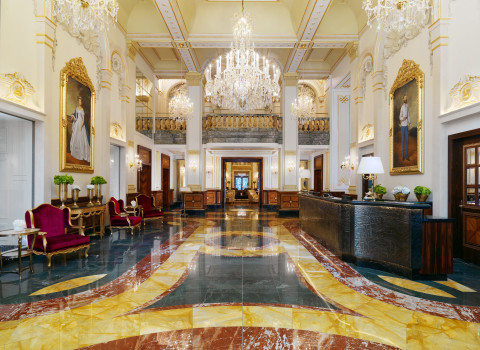
As part of a multi-million dollar investment to restore one of Europe’s most iconic hotels under The Luxury Collection, Starwood Hotels & Resorts Worldwide, Inc. today unveiled the restored public spaces at Hotel Imperial, a Luxury Collection Hotel, Vienna. The one-year, $14M restoration of the hotel’s ground floor, which includes the landmark lobby, a signature restaurant, destination bar, Imperial Cafe and Imperial Torte shop, and private event venues, was led by British interior designer Alex Kravetz, in close collaboration with the Bundesdenkmalamt (Austrian Federal Office for the Care of Monuments).
“Just as with Prince de Galles in Paris and The Gritti Palace in Venice, we are thrilled to reestablish Hotel Imperial as the social center of Vienna following its restoration,” said Paul James, Global Brand Leader, The Luxury Collection, St Regis and W Hotels Worldwide. “Restoring this Viennese icon – one of the brand’s first hotels – marks a momentous occasion for The Luxury Collection, now with over 85 hotels around the world.”
A New Imperial History
Hotel Imperial, with its palatial splendour and Italian neo-Renaissance facade, has been the residence of choice for royalty and high society visiting Vienna for the past 140 years. Originally built in 1863 as a private residence for Prince Philipp of Württemberg, the palace was converted into Hotel Imperial in time for the 1873 Universal Exhibition. Situated on the iconic Ringstrasse (Ring Boulevard), neighbouring the legendary Musikverein, Hotel Imperial is within a short walk of major attractions such as the Vienna State Opera, Kunsthistorisches Museum and Secession Building.
The original passage connecting the hotel to the Musikverein has been completely re-modelled and enlarged during the restoration. Newly re-opened, the historic Composers Entrance provides guests with a stately departure experience while en route to a performance at the world-renowned concert hall, home to the Vienna Philharmonic Orchestra.
Leading the way to this grand entryway is the Path of History, lined with archival photographs of the hotel and its illustrious guests, including the world’s finest maestros and musicians as well as aristocrats and celebrities. On the creation of the Path of History, interior designer Alex Kravetz explained, “This new gallery-like environment, which provides a link between all the major public spaces and dining venues of the hotel, was pivotal to the entire master plan of the redesign.”
Epicurean Experiences
At the heart of the hotel is 1873 – HalleNsalon, an elegant lobby bar reminiscent of a private library. The high-ceilinged bar features sparkling crystal chandeliers and restored angel friezes, beneath which guests can enjoy intimate conversations and performances by emerging Viennese musical talents.
Cafe Imperial Wien – known as the place in the heart of Vienna where philosophers, literati, artists and businessmen met for decades – provides the perfect setting to experience the iconic Viennese coffee house culture. Here, guests can taste or purchase the hotel’s famous Imperial Torte. Kravetz commented, “We wanted to create a brighter and more open ambiance while retaining the legendary atmosphere of Café Imperial Wien.” To recreate the cafe’s historic setting, the distinctive chairs and narrow window tables fashioned by Oswald Haerdtl for the cafe in 1936 have been restored while the new parquet floor and light fixtures reflect the original interiors by the Austrian architect and designer. Cafe Imperial Wien has also been expanded and features rare, book-match marble floors, integrating the new space with a show kitchen and Imperial Torte display.
The new OPUS Restaurant combines architect Josef Hoffmann’s distinctive Viennese style from the 1930s with modern aesthetics. Passing through the restored entrance, guests enter an exquisite environment featuring original burr walnut paneling, crystal chandeliers and red candle wall lights. An inspired addition to the Viennese gourmet scene, OPUS reinterprets Austrian classics using contemporary techniques and lighter flavours. The menu features premium regional produce such as wild trout, Alpine beef and heirloom vegetables.
To date, The Luxury Collection and its partners have invested over $580M to restore some of the most storied hotels in Europe. Recently completed restorations and re-openings include The Gritti Palace in Venice, Prince de Galles in Paris, Santa Marina in Mykonos and Hotel Bristol in Vienna, while Excelsior Hotel Gallia in Milan will be unveiled in December 2014 following an extensive renovation.
Hotel Imperial, www.luxurycollection.com/imperial
